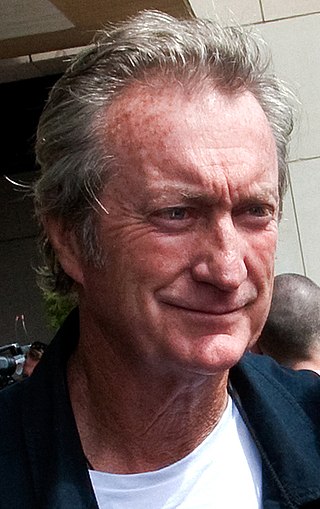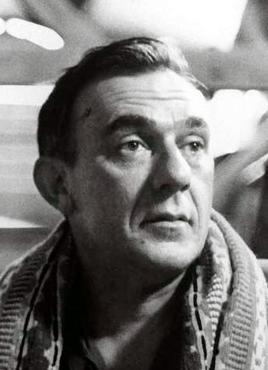Related Research Articles

Jedda, released in the UK as Jedda the Uncivilised, is a 1955 Australian film written, produced and directed by Charles Chauvel. His last film, it is notable for being the first to star two Aboriginal actors, Robert Tudawali and Ngarla Kunoth in the leading roles. It was also the first Australian feature film to be shot in colour.

Jack Thompson, AM is an Australian actor and a major figure of Australian cinema, particularly Australian New Wave. He is best known as a lead actor in several acclaimed Australian films, including such classics as The Club (1980), Sunday Too Far Away (1975), The Man from Snowy River (1982) and Petersen (1974). He won Cannes and AFI acting awards for the latter film.

Bryan Neathway Brown AM is an Australian actor. He has performed in over eighty film and television projects since the late 1970s, both in his native Australia and abroad. Notable films include Breaker Morant (1980), Give My Regards to Broad Street (1984), F/X (1986), Tai-Pan (1986), Cocktail (1988), Gorillas in the Mist (1988), F/X2 (1991), Along Came Polly (2004), Australia (2008), Kill Me Three Times (2014) and Gods of Egypt (2016). He was nominated for a Golden Globe Award and an Emmy Award for his performance in the television miniseries The Thorn Birds (1983).
Byron Eric Kennedy was an Australian film producer known for co-creating the Mad Max series of films with George Miller.
Candida Raymond is an Australian actress of film and television during the 1970s and early 1980s.

Australian rules football has been played continuously in the Australian Capital Territory since 1911 and was the most popular football code in the nation's capital Canberra between 1978 and 1982. The current governing body is AFL Canberra founded 1922, while the development body is AFL NSW/ACT established in 1999.

Robert Bruning was an Australian actor and film producer, who was the founder of film production firm Gemini Productions
Antony I. Ginnane is an Australian film producer best known for his work in the exploitation field. He was head of the Screen Producers Association of Australia from 2008 to 2011. He has been described as "Australia's Roger Corman" or Australia's equivalent to Robert Lippert.
Peter Sykes was an Australian television and film director who worked primarily in the United Kingdom. According to FilmInk, "auteurist critics always seem to pass him by."
Rod Hay was an English filmmaker who worked in Australia and South Africa. He started off as an actor, then as an assistant director and editor on many features, before becoming a writer, producer, director.
The Department is a 1974 play by David Williamson about political intrigue at a university department. It was based on Williamson's time as a lecturer at Swinburne Tech.
Oscar Ralph Whitbread was an English-Australian producer who worked extensively in television.
All the Green Year is a 1980 Australian television series based on a novel about three boys growing up near Melbourne on the eve of the Great Depression.
The Man Who Shot the Albatross is a play by Ray Lawler about the Rum Rebellion, first performed in 1971 and turned into a 1972 TV movie featuring the same cast.
Christopher Muir was an Australian director and producer, notable for his work in TV in the 1950s and 1960s. In the 1980s he was head of ABC Television drama.
"Peter Grimes" is a 1964 television play broadcast by the Australian Broadcasting Corporation. It was based on the opera by Benjamin Britten and directed by Christopher Muir.
Patrick Barton is an Australian TV director best known for his productions in the 1960s.
"Romanoff and Juliet" is a 1964 Australian television play based on the play by Peter Ustinov. It aired on 20 January 1965 in Sydney, and on 27 January 1965 in Melbourne.
Quality of Mercy is a 1975 Australian TV series, which took the format of an anthology of television plays. All the scripts were by female writers. The series was commissioned by John Croyston, the head of ABC TV Drama, and was produced in Melbourne and Sydney. It was followed later in 1975 by a companion series, The Seven Ages of Man.
John Sexton is an Australian film producer.
References
- ↑ Aveyard, Karina; Moran, Albert; Vieth, Errol (2007). "Australian Film Radio and Television School". Historical Dictionary of Australian and New Zealand Cinema. Rowman & Littlefield Publishers, Inc. p. 34. ISBN 9781538111277.
- ↑ Andrew Pike and Ross Cooper, Australian Film 1900–1977: A Guide to Feature Film Production, Melbourne: Oxford University Press, 1998 p315
- ↑ "AUST. REPRESENTATION AT ASIAN FILM FESTIVAL". Filmnews . Vol. 7, no. 9. New South Wales, Australia. 1 October 1977. p. 3. Retrieved 16 January 2017– via National Library of Australia.
- ↑ "Logies for Ernie and Ding Dong". The Canberra Times . Vol. 49, no. 14, 008. Australian Capital Territory, Australia. 8 March 1975. p. 1. Retrieved 16 January 2017– via National Library of Australia.
- ↑ "HIGH ROLLING". The Australian Women's Weekly . Vol. 45, no. 12. Australia. 24 August 1977. p. 48. Retrieved 8 April 2019– via National Library of Australia.
- ↑ "'Glitter and glamour' at film premiere". The Canberra Times . Vol. 57, no. 17, 200. Australian Capital Territory, Australia. 31 October 1982. p. 14. Retrieved 8 April 2019– via National Library of Australia.
- ↑ "Cosmopolitan Twin Cinemas". The Canberra Times . Vol. 59, no. 17, 973. Australian Capital Territory, Australia. 13 December 1984. p. 11 (SUPPLEMENT TO THE CANBERRA TIMES). Retrieved 8 April 2019– via National Library of Australia.